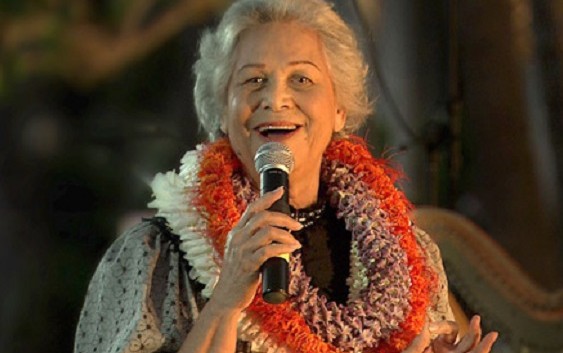Emma Veary

Emma Maynon Kaipuala Veary Lewis started her music career somewhat inauspiciously – singing with the E.K. Fernandez circus at the tender age eight. But after winning any number of talent and singing contests, Emma was singing at every major Waikiki nightspot while still in high school. She went on to study opera and perform in the stock companies of such Broadway shows as Carousel, Showboat, Pal Joey, West Side Story, The King and I, andFlower Drum Song. But she is best remembered for a series of four LP records she made with arranger/producer Jack de Mello.
The recordings were not unique but, rather, a throwback to another era. Veary’s specially trained voice required a very specific king of instrumental support – a type of support that de Mello specialized in. It was the kind of music one might have heard a half-century earlier when Charles E. King arranged his own compositions for trained voices like those of Sam Kapu and Helen Desha Beamer. In 1925 such arrangements would have been the popular music of the day. But in 1975, this music might be considered classical because of the orchestral arrangements involving large string sections and even a harp. But regardless of the era in which the music is being performed, some compositions require just such instrumental support and the rare vocal technique that Veary brought to the table. Ethnomusicologist and kumu hula Amy Ku`uleialoha Stillman comments on this at her blog:
De Mello had already been arranging and recording Hawaiian songs with full symphonic orchestra. Adding Emma Vearyʻs classically trained bel canto voice completed the sound of taking Hawaiian songs into the sonic world of classical music… Emma Vearyʻs voice is classic. It is a trained, disciplined voice. Which is exactly what is required to sing many of the songs written by Charles E. King. These songs have melodies that require vocal technique. Many of these melodies are unforgiving to singers without vocal training, as they struggle to complete entire phrases on one breath, or soar over a range of notes while barely hitting some or most (or all!) of the pitches in tune.
(You can read more of Dr. Stillman’s comments on her blog. You will find that – like me – she is a huge fan of this style of music and of Ms. Veary.)
It is not clear after all of these years whether it was Veary’s remarkable recordings that led to her engagements at Waikiki’s finest showrooms throughout the 1970s – including lengthy stays at both the Halekulani and Royal Hawaiian Hotels – or if it was her sold-out performances at these prestigious venues that led to her recording contract with de Mello’s Music of Polynesia record label. In either case, the records are our gateway to those performances, venues, and Veary’s voice in that era. Although, admittedly, her voice sounds pretty much the same today as it did 40 years ago as evidenced by the 2011 PBS Hawai`i TV special in her honor captured live under the kiawe tree at the Halekulani Hotel’s House Without A Key.
Ho`olohe Hou Radio honors Veary’s February 3rd birthday by sharing some of her rarest recordings all week long – including clips from her live performances in the Monarch Room of the Royal Hawaiian Hotel in the 1970s. And we will also feature right here the rarest-of-the-rare: A video of Emma Veary on the short-lived Hawaii Calls TV program (from 1965-66) from the Ho`olohe Hou Radio archives.

